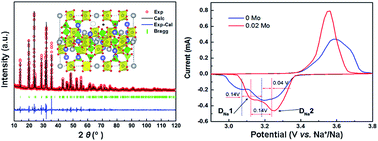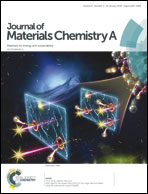High valence Mo-doped Na3V2(PO4)3/C as a high rate and stable cycle-life cathode for sodium battery†
Abstract
NASICON-structure Na3V2(PO4)3 (NVP) is a potential cathode material for sodium ion battery, which is still confronted with low rate performance because of its poor conductivity. To address this problem, high-valance Mo6+ ion was introduced into NVP. The crystal structure, electrochemical performances, sodium ion diffusion kinetics and ion transfer mechanism of high valence Mo-doped Na3−5xV2−xMox(PO4)3/C (0 < x < 0.04) were investigated. X-ray diffraction, electron microscopy and XPS data confirmed high purity NASICON phosphate phases. The Na ion diffusion process was identified through CV measurement, which clearly shows rapid sodium ion transportation in the Mo-doped NASICON materials. Moreover, DFT calculations proved that Na ion diffusion is promoted by Mo doping. Benefiting from the superior Na ion kinetics, Na2.9V1.98Mo0.02(PO4)3 exhibited a performance of 90 mA h g−1 at 10C and preserved 83.5% of the original capacity after 500 cycles. Our studies demonstrate that high-valence Mo doped Na3V2(PO4)3/C is a promising cathode material for sodium ion batteries with super-high rate capability and stable cycle life.



 Please wait while we load your content...
Please wait while we load your content...